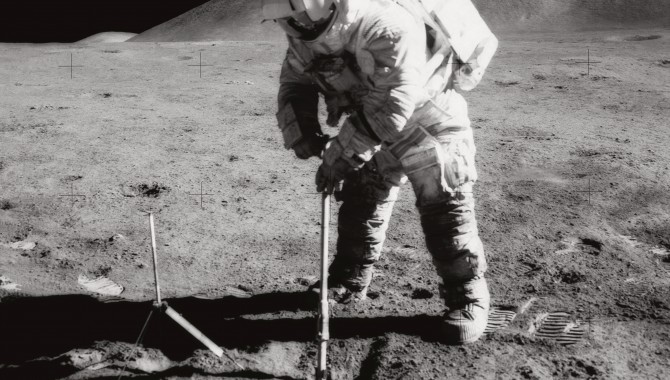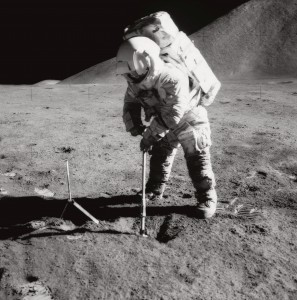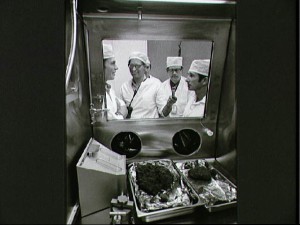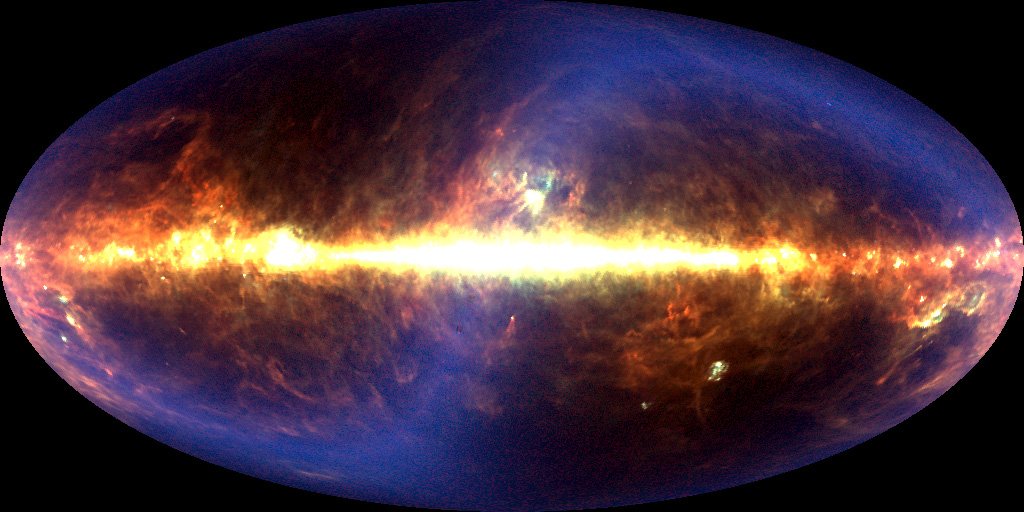
By Gary Lofgren
I came fresh out of graduate school to the then Manned Spacecraft Center (MSC—later Johnson Space Center) in 1973, prepared to build a laboratory to study the formation of basaltic rocks. Little did I know what was to come. I became a member of the Geology Branch. One of our primary activities was to train Apollo astronauts how to do geology on the moon. I eventually built the science laboratory and accomplished all I hoped to do when I came. My participation in the Apollo program, however, has been the highlight of my science career.

Astronaut James B. Irwin, lunar module pilot, uses a scoop to make a trench in the lunar soil during Apollo 15 EVA. Mount Hadley rises above the plain in the background.
Photo Credit: NASA; David Scott
It is difficult to describe my excitement when I was about to see rocks from the moon for the first time. Apollo 11 went to a mare area, the Sea of Tranquility. We expected that basaltic lavas would be the most common kind of rock in the so-called lunar seas, and they were. The other kind of rock, the soil breccias, were a surprise and were our initiation to the rocks produced during the many impacts evident on the moon.
Shortly after the samples were returned, I was asked to participate in the process of distributing them to scientists for study. Many scientists needed samples of a definite shape—a cube, for instance. Such samples would have to be cut with a saw, but no saw suitable for the task existed. Rocks are usually sawn with water as a lubricant and coolant, but using water or any liquid that would have contaminated the samples was unacceptable. One of the scientists developed a saw that used a diamond-impregnated wire to cut the samples dry. It was a delicate machine that needed constant attention. I was given the task of learning the saw and doing all the cutting for the initial Apollo 11 allocation of samples that required sawing. This gave me a chance to study the samples at my leisure. I used this opportunity to record my observations, which later became part of an introductory paper in the proceedings of the first lunar science conference. I went on to study the lunar basalts in my laboratory for the next ten years.
Teaching Geology to Astronauts
Far and away the most memorable aspect of my Apollo experience was working as part of a team of geologists that taught the astronauts geology. Being a rookie, I began working with the backup crew for Apollo 13, John Young and Charlie Duke, who eventually flew on Apollo 16. Training began in earnest when I was assigned to work with the Apollo 15 crew as the MSC representative. Apollo 15 was the first of the long-stay “J” missions. They would have three extra-vehicular activities (EVAs) on the surface totaling more than twenty hours. In addition, they would have a vehicle, the Lunar Rover, to extend the area over which they would conduct scientific experiments. Clearly the science effort was becoming huge. Dave Scott, the mission commander, recognized that fact and dedicated a large block of his and Jim Irwin’s time to becoming field geologists. They would land on basalt flow with Mount Hadley, part of the early lunar highland crust, a short distance to the east of the landing site. This would be the first landing with an objective to sample the primitive lunar crust. Training would have to prepare Dave and Jim to recognize and sample both basalt and lunar crustal rocks. They would set a standard for geologic fieldwork that would spur on the later crews.
The spectacular scientific success of the A-15 mission and Apollos 16 and 17 to follow—with their cumulative total of approximately sixty hours on the lunar surface—was in large part a result of extensive geologic field training. The geologic objectives for these missions were complex. What made the training so successful, in addition to great teachers and dedicated astronauts, is worth noting for future missions.
A-15 was a turning point in the length and intensity of the training in geology. Training included sixteen to eighteen field exercises of two to three days each over eighteen months, augmented by limited classroom study. Every attempt was made to train in geologic settings that simulated some aspect of the scientific objectives of the mission. Apollo 15 would land between Hadley Rille and Mount Hadley on the edge of the Imbrium Basin. The crews were asked to systematically observe everything from the far distance to the near field and ultimately developed astute observation skills and a geologic vocabulary in common with the geologists in the mission science backroom. Most of the field exercises were focused on specific mission objectives to give the astronauts the background they needed to fully understand the scientific objectives and their rationale. One of the most important classroom activities was to learn basic lunar rock types by direct observation of Apollo lunar samples in the Lunar Receiving Laboratory. Because I was at MSC and close to the lunar samples, I took on the task of familiarizing the crew with the lunar samples we already had collected on previous missions.
The primary teaching technique that evolved during the early training was perfected during the Apollo 15 training under the tutelage of Lee Silver, a Caltech professor who had been teaching field geology to students for years and was strongly encouraged to participate by Jack Schmitt. Jack would be on the A-17 prime crew and was on the backup crew for A-15. The training traverses were designed to mimic what would happen on the moon as closely as possible. Routine tasks such as sample collection and documentation were practiced on all traverses until they became second nature, freeing the astronauts to observe their surroundings. Every effort was made to visit terrestrial geologic localities that mimicked the geologic problems at the lunar landing sites as closely as possible.
Traverses were designed by knowledgeable geologists with a definite path to follow and specific science objectives to be achieved at designated stations indicated on the traverse. The real mission capcoms, astronauts Joe Allen (prime) and Bob Parker (backup), acted as a communication link between the crew in the field and a science backroom comprising geologists not familiar with the geology that would be encountered by the astronauts. During these exercises, Joe and Bob developed their ability to prod and guide the activities of the crew to complete their designated tasks. The most important part of this training exercise was the face-to-face debriefing where the crew, together with the capcoms and the science backroom geologists, walked over the entire traverse and discussed the degree to which the crew had been able to communicate the geology they were seeing in the field.
In the early exercises the gap was large, but with repetition over many field trips that gap disappeared and a common language was born. The capcoms developed an intimate knowledge of how the crew worked, what limitations were imposed by the rigor of the defined traverse, and how to best interact with the crew to get the job done. The geologists learned how difficult it would be to communicate with the crew and how best to make that happen. Most importantly, the crews had the opportunity to learn how to communicate with the geologists effectively and how and when to ask for advice. I believe this activity alone is primarily responsible for the success of the geologic traverses. These debriefings forced everybody to recognize their deficiencies and to eliminate them. Ultimately, this activity formed the cohesive team that succeeded so well. I know also that if I were to teach students field geology, I would use many aspects of this training with my students.
More than anything else, though, the work succeeded because the crews took ownership of the missions and dedicated themselves to their success.

Astronauts David R. Scott, left, and James B. Irwin, right, join Manned Spacecraft Center geologists in looking at some of the first Apollo 15 samples to be opened in the Non-Sterile Nitrogen Processing Line in the Manned Spacecraft Center’s Lunar Receiving Laboratory. Holding the microphone and making recorded tapes of the two Apollo 15 crewmen’s comments is Dr. Gary Lofgren.
Photo Credit: NASA Johnson Space Center
Dave Scott was an innovative commander. It was his idea that he and Jim Irwin would put on their space suits and open the docking hatch on the top of the Lunar Module to view the area. From this vantage point, approximately 20 ft. above the surface, the view was spectacular. He was able to find all the major landmarks noted on their traverse maps, describe the geology in the distance, and evaluate the surface mobility. An exciting moment came during the second traverse, when Dave spotted a white rock on the surface whose cleavage surfaces reflected the sunlight and caught his attention. He retrieved the rock and quickly identified the white mineral as plagioclase feldspar. This was why they came to the base of Mount Hadley—to find a piece of the primitive lunar crust. One major mission objective accomplished.
They made another equally important discovery there. We were also looking for olivine-rich rocks. Olivine is a green mineral, and they saw some rocks with a green cast. These ultimately proved to contain not olivine but a green glass brought to the surface by a basaltic fire fountain. This green glass from deep in the moon revealed much about the nature of its source and the interior of the moon.
Late one night, near midnight, I left the building where I had been in a science backroom to support the crew after this EVA. There was a nearly full moon shining overhead. I looked up and realized that the two guys I had just watched collect some great rocks were on that moon. It was one of those moments you never forget.
There were other moments. In the Lunar Receiving Lab (LRL) where the samples were returned and the first three crews quarantined, I remember Dave and Jim’s excitement when they first saw the rocks they had collected on the lunar surface in the calm of the laboratory. They recounted how they noticed these important crustal rocks and gave us a better picture of their setting on the surface. There were several rapt geologists gathered around. I felt that the many training hours showing the crew the lunar rocks had paid dividends.
Preserving and Protecting Lunar Geology
Thirty years after the mission and a long career studying first lunar basalts and then meteorites, I returned to Apollo. I became the curator of the lunar samples. They were now in my care. After thirty years, the samples have lost some of their scientific luster to many people but not to me. I rededicated myself to preserving the Apollo lunar sample heritage. A new building to house the samples was finished in 1979, and it has served them well. They are well protected from Earth’s environment, which would quickly destroy the lunar character of the samples. But a nearly twenty-five-year-old building needed renewing. That became my mission. Now, after ten years of effort and nearly $3 million, that renewal is nearly complete. But preserving the building is only part of the job. The documentation of forty years of processing lunar samples needed to be preserved in a useful, accessible form.
The story of the lunar database is a story of the development of the digital age from the late sixties to the present. The first version was contained in a primitive computer that was accessed with a 300-baud phone modem, the kind that had you put the phone receiver in a cradle. It went through the stage of punch cards and then magnetic tapes. Eventually we reached a critical stage when the database was still on an outmoded VAX computer for which no spare parts existed. The transition to a modern database was a more demanding task than I ever envisioned. I hoped to get $50,000 to make this transition. The cost was ultimately closer to $1 million and took five programmers fourteen months to accomplish. Without this effort, we would have been nearly out of the business of allocating samples if the VAX failed. We would have had to go back to the days of pencil and paper. I am comfortable now that all the necessary changes have been made or are currently in process to house and care for the samples properly for decades to come. They are indeed a national treasure.









